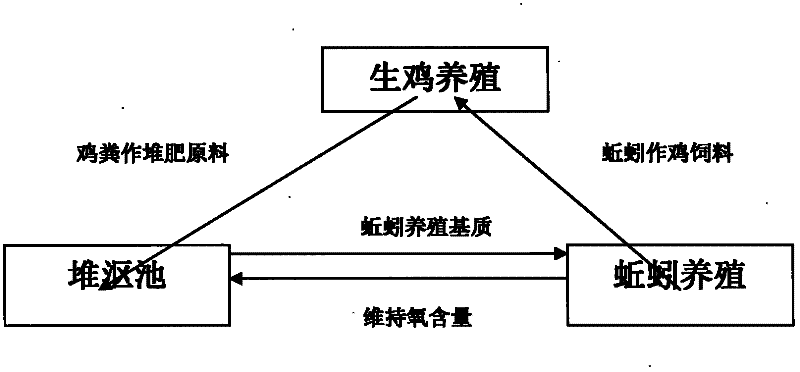Method for improving degradation and aerobic composting of cow dung with earthworm
An aerobic composting and earthworm technology, which is applied in the agricultural field, can solve the problems of long decomposing time and complex factors, and achieve the effects of improving compost quality, improving compost fertilizer efficiency, good environment and economic benefits
- Summary
- Abstract
- Description
- Claims
- Application Information
AI Technical Summary
Problems solved by technology
Method used
Image
Examples
Embodiment 1
[0017] During winter breeding, collect 2 tons of cow dung that has passed the high-temperature fermentation period and has a moisture content of 50%-60%, and put it into a 2m×2m×2.5m improved retting tank, covering the tank body, and the height of the pile is 0.4m. After the stacking is completed, about 8,000 earthworms of the Ohira No. 2 species are inoculated. After the earthworms have completely entered the heap, cover the surface of the heap with straw and water it thoroughly. During the breeding process, the heap samples were collected to test the pH value. The suitable pH range for earthworms to grow is between 6.5 and 8.5. If it is detected that the pH of the pile is not within the appropriate range, a certain dose of soda (NaHCO 3 ) solution adjustment, when it is higher than 8.5, adjust the pH with a low-concentration glacial acetic acid solution to adjust the pH to about 7.5-8.
[0018] The suitable growth temperature for earthworms is 10-25°C, and the temperature...
Embodiment 2
[0021] During summer breeding, collect 5 tons of cow dung that has passed the high-temperature fermentation period and has a moisture content of 65%-70%, and put it into a 5m×2.5m×2.5m improved composting tank to cover the tank body with a height of 0.4m. After the stacking is completed, inoculate about 15,000 earthworms of Daping No. 2 species. After the earthworms have completely entered the pile, cover the surface of the pile with straw and water thoroughly. During the breeding process, the heap samples were collected to test the pH value. The suitable pH range for earthworms to grow is between 6.5 and 8.5. If it is detected that the pH of the pile is not within the appropriate range, a certain dose of soda (NaHCO 3 ) solution adjustment, when it is higher than 8.5, adjust the pH with a low-concentration glacial acetic acid solution to adjust the pH to about 7.5-8.
[0022] The suitable growth temperature for earthworms is 10-25°C, and the temperature in summer is high, w...
Embodiment 3
[0026] Collect 5 tons of fresh cow dung, with a moisture content of about 80%, and put it into a 5m×2.5m×2.5m improved retting tank, covering the tank body, and the height of the pile is 0.4m. After stacking for about 15 days, monitor the temperature change of the pile. After the high temperature period of fermentation has passed, the temperature of the pile has dropped to about 20 degrees, and the earthworms can be inoculated when the moisture content is about 60%.
[0027] Inoculate about 15,000 earthworms of Daping No. 2 species. After the earthworms have completely entered the heap, cover the surface of the heap with straw and water thoroughly. Monitor the changes in the pH of the pile to maintain it at around 7.5-8.
[0028] Water once every 3 days in winter and twice a day in summer to keep the temperature of the heap at 20°C and the moisture content at about 60%. Pick out in time after the earthworms reproduce. About 40 days in summer and about 2 months in winter, the...
PUM
 Login to View More
Login to View More Abstract
Description
Claims
Application Information
 Login to View More
Login to View More - R&D
- Intellectual Property
- Life Sciences
- Materials
- Tech Scout
- Unparalleled Data Quality
- Higher Quality Content
- 60% Fewer Hallucinations
Browse by: Latest US Patents, China's latest patents, Technical Efficacy Thesaurus, Application Domain, Technology Topic, Popular Technical Reports.
© 2025 PatSnap. All rights reserved.Legal|Privacy policy|Modern Slavery Act Transparency Statement|Sitemap|About US| Contact US: help@patsnap.com


